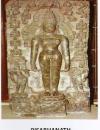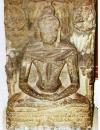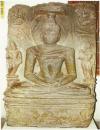Archaeology
You are here
Archaeology
Introduction:- The exhibits of the newly renovated section are mainly of sculptures ranging from the third century B. C. to the late medieval period, displayed in three big halls on well-designed pedestals under both natural and artificial lighting conditions. The portion of an Asokan pillar brought from Patna Museum, has been regarded as the earliest specimen of the section. The heavy and crude Naga and Yaksha images collected from the surrounding area of Bhubaneswar comes next. Among other notable sculptures the Buddha image of Khadipada, Amoghasidhi of G. Udayagiri, Lokanatha from Bhubaneswar, Jaina Tirthankaras from Podasingidi and Charampa, Brahmanical figures like Sapta Matrukas from Dharmasala, Dikpala figures from Bhubaneswar, Krishna-Vishnu from Dharmasala and a number of Puranic panels and Gopinath images from different parts of the State. A brief account of each school of sculptures is given below:-
 |
Jain AntiquitiesLike Buddhist and Brahmanical sculptures, the State of Odisha was once rich in Jaina antiquities. We have traces of those relics seen in Jeypore and Nandapur of Koraput district: Bhubaneswar, Puri, Kakatpur in Puri district; Cuttack town, Pratapnagari, Chaudwar, Tigiria, Jajpur of Cuttack district; Anandapur area of Keonjhar district; Charampa, Ayodhya, Martasol of Balasore district and Khiching, Baripada. Badasahi of Mayurbhanj district. |
 |
Jain Tirthankaras of PodasingidiPodasingidi is an important archaeological site in the dense forest of the Baula hill ranges in Anandapur Subdivision of Keonjhar district. Out of many, only two Risabhanath sculptures have been brought from the site and they are now under display in the first hall of the Archaeological gallery. |
 |
Jaina antiquities of CharampaCharampa (Bhadrak) in Balasore district also yielded a large number of Jaina antiquities of which four have been brought to the Odisha State Museum for display. A peculiar feature of these images is that a number of cut marks are found on their body. These cut marks are certainly a deviation from the other school of Jaina art as if those were purposely effected by the artists. |
 |
RisabhanathaThe first image of the series is the figure of Risabhanatha measuring 5'=2"X2'=3". It is standing in Kayotsarga pose and flanked by Chauri bearers, Bharata and Bahuvali. The stele has an oval halo with flying Gandharvas on either side with garlands in hands. Around the image eight planets have been carved which is taken to be as the Astagraharchita Risabhanath. His mark of cognizance, the bull is carved below the pedestal. |
 |
AjitanathaThe second image of the group is popularly known as Ajitanatha in view of the tact that its symbol, the elephant, found expression below the pedestal. He is sitting in meditative posture (Yogasana) prominently displaying the cut marks in the body. He measures 3' =8" X 2' = 7". The right palm of the figure is placed on the left which touches both the legs arranged in padmasana posture. |
 |
SantinathaThe third image of this collection, the figure of Santinatha is also seated in padmasana in meditative mood. The cognizance mark, the deer is placed below the double petalled lotus pedestal duly flanked by devotees. The pedestal is supported by lions.thauri-bearers and flying Gandharvas flank the figure at the bottom and top respectively, like the above its hair is also arranged in locks. |
